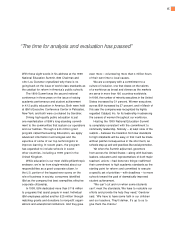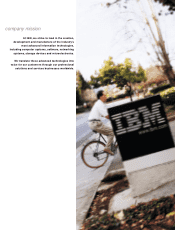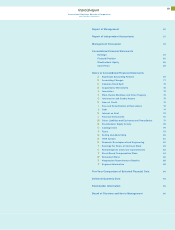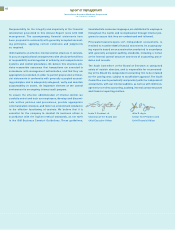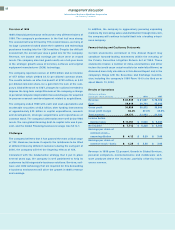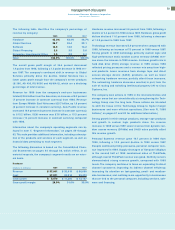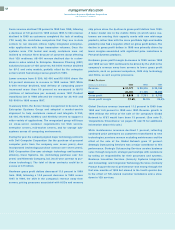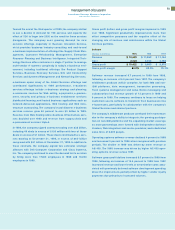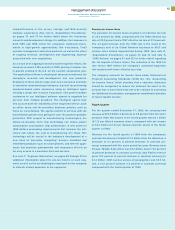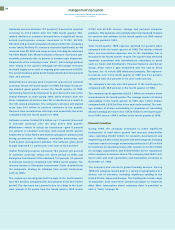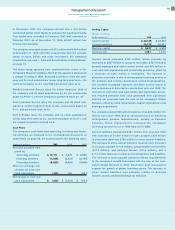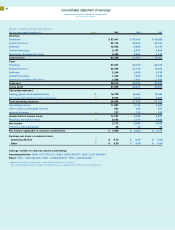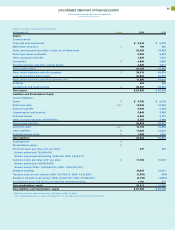IBM 1999 Annual Report Download - page 59
Download and view the complete annual report
Please find page 59 of the 1999 IBM annual report below. You can navigate through the pages in the report by either clicking on the pages listed below, or by using the keyword search tool below to find specific information within the annual report.
management discussion
International Business Machines Corporation
and Subsidiary Companies
competitiveness in the server, storage and Web-security
markets, respectively. (See note D, “Acquisitions/ Divestitures,”
on pages 72 and 73 for further detail about the in-process
research and development charge.) In addition, the increases in
both 1999 and 1998 reflect the company’s continued invest-
ments in high-growth opportunities like e-business, Tivoli
systems management and Lotus products, as well as the effect
of ongoing research, development and engineering expense
associated with new acquisitions.
As a result of its ongoing research and development efforts, the
company received 2,756 patents in 1999, placing it number one
in patents granted in the U.S. for the seventh consecutive year.
The application of these technological advances transforms the
company’s research and development into new products.
Examples of these efforts range from new e-business solutions
to innovative manufacturing techniques. A patent for performing
computer-based online commerce using an intelligent agent
will play a major role in future e-business. This patent enables
customers to use intelligent software agents to negotiate for
services from multiple providers. The intelligent agents take
into account both the availability of the requested service, such
as airline seats, and the providers’ business policies, such as
those on cancellations. The agents commit to services with the
most flexible policies first, giving the user the greatest possible
protection. With respect to manufacturing technologies, the
silicon-on-insulator (SOI) chip technology can reduce power
consumption and improve chip performance. A new patent in
1999 defines processing improvements that increase the effi-
ciency and reduce the cost of manufacturing SOI chips. This
technology will be crucial in the industry’s development of a
new class of “pervasive computing” devices, handheld and
embedded products such as smart phones, and Internet appli-
ances that business professionals and consumers will rely on
for easy access to e-business data and services.
See note Y, “Segment Information,” on pages 89 through 93 for
additional information about the pre-tax income of each seg-
ment, as well as the methodologies employed by the company
to allocate shared expenses to the segments.
Provision for Income Taxes
The provision for income taxes resulted in an effective tax rate
of 34.4 percent for 1999, compared with the 1998 effective tax
rate of 30.0 percent and a 1997 effective tax rate of 32.5 percent.
The 4.4 point increase from the 1998 rate is the result of the
company’s sale of its Global Network business to AT&Tand
various other actions implemented during 1999. (See note D,
“Acquisitions/ Divestitures,” on pages 72 and 73 and note R,
“1999 Actions,” on pages 81 and 82 for further detail regarding
the tax impacts of these items.) The reduction in the 1998 tax
rate versus 1997 reflects the company’s continued expansion
into markets with lower effective tax rates.
The company accounts for income taxes under Statement of
Financial Accounting Standards (SFAS) No. 109, “Accounting
for Income Taxes,” which provides that a valuation allowance
should be recognized to reduce the deferred tax asset to the
amount that is more likely than not to be realized. In assessing
the likelihood of realization, management considered estimates
of future taxable income.
Fourth Quarter
For the quarter ended December 31, 1999, the company had
revenue of $24.2 billion, a decrease of 3.8 percent from the same
period in 1998. Net income in the fourth quarter was $2.1 billion
($1.12 per diluted common share), compared with net income
of $2.3 billion ($1.24 per diluted common share) in the fourth
quarter of 1998.
Revenue for the fourth quarter of 1999 from the company’s
end-user businesses totaled $10.4 billion from the Americas, a
decrease of 3.7 percent (2 percent decrease in constant cur-
rency) compared with the same period last year. Revenue from
Europe/ Middle East/ Africa was $7.2 billion, down 15.0 percent
(6 percent decrease in constant currency). Asia Pacific revenue
grew 12.3 percent (2 percent increase in constant currency) to
$4.4 billion. OEM revenue across all geographies was $2.2 bil-
lion, a 12.5 percent increase (12 percent in constant currency)
compared with the fourth quarter of 1998.
57


